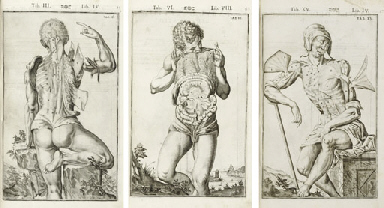TOYO, Tamawaki (1705-1762). Zôshi [Notes on the Viscera]. Kyoto: Horeki 9, 1759.
TOYO, Tamawaki (1705-1762). Zôshi [Notes on the Viscera]. Kyoto: Horeki 9, 1759. 2 volumes, 263 x 184 mm. Four hand-colored wood-engraved illustrations in text, from sketches taken on the spot by the author's disciple Asanuma Suketsune. Contemporary plain wrappers; wooden box. Provenance : Jean Blondelet (sold Tajan, Paris, 23 October 2001, lot 11). FIRST EDITION OF THE FIRST WORK RECOUNTING THE FIRST OFFICIALLY AUTHORIZED DISSECTION IN JAPAN, WHICH WAS AUTHORIZED BY THE GOVERNOR OF KYOTO IN 1754. Human dissections began in Japan roughly four hundred years after the practice began in Europe. From manuscripts of the Anathomia , a dissection manual written in 1316 by Mondino de Luzzi (ca 1265-1326), we know that the practice of human dissection, which may have originated with Heraphilus of Alexandria (fl. 290 B.C.E), and went out of fashion in the Roman Empire, was performed, if only in an occasional and perfunctory manner, at European medical schools from the fourteenth century onward. In Japan, which had little contact with the west, medicine evolved primarily following the Chinese tradition, based upon a non-empirical, holistic and quasi-religious view of the body in which an exact knowledge of anatomy was meaningless. Under the influence of Confucianism human dissection was prohibited in Japan, and Japanese knowledge of human anatomy was based upon dissections of animals such as otters, dogs, and monkeys. There are no records of human dissection in Japan before the eighteenth century. However, some Western medical knowledge did gradually become introduced to the Japanese, beginning in the mid-to late-seventeenth century, through Dutch physicians and medical books belonging to these physicians at the Dutch trading settlement on the artificial island of Dejima off Nagasaki. As a result of the dissection of an executed criminal recorded in this book, the author, Yamawaki Toyo (1705-62), court physician at Kyoto, was able to demonstrate the accuracy of anatomical details that he had learned from Western medical books, and could begin to prove the inaccuracy of traditional Chinese authorities. The work was illustrated with four hand-colored woodcuts after sketches made at the dissection by Asanuma Suketsune, a painter of the Maruyama or Shijo school in Kyoto. These beautiful images ARE THE FIRST ATTEMPTS TO INTEGRATE TRADITIONAL JAPANESE VIEWS OF THE INTERIOR OF HUMAN BODY WITH THE RESULTS OF ACTUAL OBSERVATION FROM DISSECTION. Bowers, Medical Education in Japan (1965) pp. 15, 18; Mestler, "A Galaxy of Old Japanese Medical Books I", Bull. Med. Lib. Assoc. , XLII (1954) p. 310. (2)
TOYO, Tamawaki (1705-1762). Zôshi [Notes on the Viscera]. Kyoto: Horeki 9, 1759.
TOYO, Tamawaki (1705-1762). Zôshi [Notes on the Viscera]. Kyoto: Horeki 9, 1759. 2 volumes, 263 x 184 mm. Four hand-colored wood-engraved illustrations in text, from sketches taken on the spot by the author's disciple Asanuma Suketsune. Contemporary plain wrappers; wooden box. Provenance : Jean Blondelet (sold Tajan, Paris, 23 October 2001, lot 11). FIRST EDITION OF THE FIRST WORK RECOUNTING THE FIRST OFFICIALLY AUTHORIZED DISSECTION IN JAPAN, WHICH WAS AUTHORIZED BY THE GOVERNOR OF KYOTO IN 1754. Human dissections began in Japan roughly four hundred years after the practice began in Europe. From manuscripts of the Anathomia , a dissection manual written in 1316 by Mondino de Luzzi (ca 1265-1326), we know that the practice of human dissection, which may have originated with Heraphilus of Alexandria (fl. 290 B.C.E), and went out of fashion in the Roman Empire, was performed, if only in an occasional and perfunctory manner, at European medical schools from the fourteenth century onward. In Japan, which had little contact with the west, medicine evolved primarily following the Chinese tradition, based upon a non-empirical, holistic and quasi-religious view of the body in which an exact knowledge of anatomy was meaningless. Under the influence of Confucianism human dissection was prohibited in Japan, and Japanese knowledge of human anatomy was based upon dissections of animals such as otters, dogs, and monkeys. There are no records of human dissection in Japan before the eighteenth century. However, some Western medical knowledge did gradually become introduced to the Japanese, beginning in the mid-to late-seventeenth century, through Dutch physicians and medical books belonging to these physicians at the Dutch trading settlement on the artificial island of Dejima off Nagasaki. As a result of the dissection of an executed criminal recorded in this book, the author, Yamawaki Toyo (1705-62), court physician at Kyoto, was able to demonstrate the accuracy of anatomical details that he had learned from Western medical books, and could begin to prove the inaccuracy of traditional Chinese authorities. The work was illustrated with four hand-colored woodcuts after sketches made at the dissection by Asanuma Suketsune, a painter of the Maruyama or Shijo school in Kyoto. These beautiful images ARE THE FIRST ATTEMPTS TO INTEGRATE TRADITIONAL JAPANESE VIEWS OF THE INTERIOR OF HUMAN BODY WITH THE RESULTS OF ACTUAL OBSERVATION FROM DISSECTION. Bowers, Medical Education in Japan (1965) pp. 15, 18; Mestler, "A Galaxy of Old Japanese Medical Books I", Bull. Med. Lib. Assoc. , XLII (1954) p. 310. (2)















Testen Sie LotSearch und seine Premium-Features 7 Tage - ohne Kosten!
Lassen Sie sich automatisch über neue Objekte in kommenden Auktionen benachrichtigen.
Suchauftrag anlegen